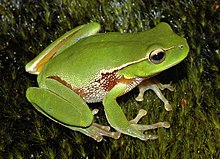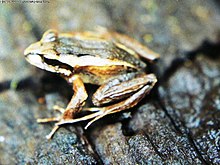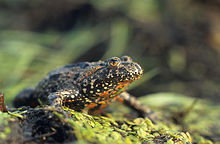The Amphibian Portal
Amphibians are ectothermic, anamniotic, four-limbed vertebrate animals that constitute the class Amphibia. In its broadest sense, it is a paraphyletic group encompassing all tetrapods excluding the amniotes (tetrapods with an amniotic membrane, such as modern reptiles, birds and mammals). All extant (living) amphibians belong to the monophyletic subclass Lissamphibia, with three living orders: Anura (frogs and toads), Urodela (salamanders), and Gymnophiona (caecilians). Evolved to be mostly semiaquatic, amphibians have adapted to inhabit a wide variety of habitats, with most species living in freshwater, wetland or terrestrial ecosystems (such as riparian woodland, fossorial and even arboreal habitats). Their life cycle typically starts out as aquatic larvae with gills known as tadpoles, but some species have developed behavioural adaptations to bypass this.
Young amphibians generally undergo metamorphosis from an aquatic larval form with gills to an air-breathing adult form with lungs. Amphibians use their skin as a secondary respiratory interface and some small terrestrial salamanders and frogs lack lungs and rely entirely on their skin. They are superficially similar to reptiles like lizards, but unlike reptiles and other amniotes, require access to water bodies to breed. With their complex reproductive needs and permeable skins, amphibians are often ecological indicators to habitat conditions; in recent decades there has been a dramatic decline in amphibian populations for many species around the globe.
The earliest amphibians evolved in the Devonian period from tetrapodomorph sarcopterygians (lobe-finned fish with articulated limb-like fins) that evolved primitive lungs, which were helpful in adapting to dry land. They diversified and became ecologically dominant during the Carboniferous and Permian periods, but were later displaced in terrestrial environments by early reptiles and basal synapsids (predecessors of mammals). The origin of modern lissamphibians, which first appeared during the Early Triassic, around 250 million years ago, has long been contentious. The most popular hypothesis is that they likely originated from temnospondyls, the most diverse group of prehistoric amphibians, during the Permian period. Another hypothesis is that they emerged from lepospondys. A fourth group of lissamphibians, the Albanerpetontidae, became extinct around 2 million years ago. (Full article...)
Selected frog article
Selected salamander article
The Caudata are a group of amphibians containing the extant salamanders (the order Urodela) and all extinct species of amphibians more closely related to salamanders than to frogs. They are typically characterized by a superficially lizard-like appearance, with slender bodies, blunt snouts, short limbs projecting at right angles to the body, and the presence of a tail in both larvae and adults.
Disagreement exists between different authorities as to the definition of the terms "Caudata" and "Urodela". Some maintain that Urodela should be restricted to the crown group, with Caudata being used for the total group. Others restrict the name Caudata to the crown group and use Urodela for the total group. The former approach seems to be most widely adopted and is used in this article. (Full article...)List of selected salamander articles
|
|---|
Did you know? –

- ... that the endangered Mazumbai warty frog and the more common Krefft's warty frog are both found in the Usambara Mountains in Tanzania?
- ... that the newly described Microhyla borneensis is the smallest species of frog in the Old World?
- ... that reproduction in the East African toads Nectophrynoides viviparus and Nectophrynoides laevis involves females giving birth to live young?
Selected amphibian type
Toad is a common name for certain frogs, especially of the family Bufonidae, that are characterized by dry, leathery skin, short legs, and large bumps covering the parotoid glands.
A distinction between frogs and toads is not made in scientific taxonomy, but is common in popular culture (folk taxonomy), in which toads are associated with drier, rougher skin and more terrestrial habitats. (Full article...)List of selected amphibian type articles
|
|---|
Selected images
Selected toad article

The European green toad (Bufotes viridis) is a species of true toad found in steppes, mountainous areas, semi-deserts, urban areas and other habitats in mainland Europe, ranging from far eastern France and Denmark to the Balkans, Western Russia and the Caucasus. As historically defined, the species ranged east through the Middle East and Central Asia to western China, Mongolia and northwestern India, and south through Italy and the Mediterranean islands to North Africa.
Following genetic and morphological reviews, 14 populations (all largely or entirely Asian, except for the African and Balearic green toads) are now regarded as separate species. These species and the European green toad are placed in their own genus Bufotes, but they were included in Bufo. (Full article...)Selected caecilian article
Need help?
Do you have a question about Amphibians that you can't find the answer to?
Consider asking it at the Wikipedia reference desk.
Topics
Subcategories
Related portals
Associated Wikimedia
The following Wikimedia Foundation sister projects provide more on this subject:
-
Commons
Free media repository -
Wikibooks
Free textbooks and manuals -
Wikidata
Free knowledge base -
Wikinews
Free-content news -
Wikiquote
Collection of quotations -
Wikisource
Free-content library -
Wikiversity
Free learning tools -
Wiktionary
Dictionary and thesaurus
© MMXXIII Rich X Search. We shall prevail. All rights reserved. Rich X Search










































